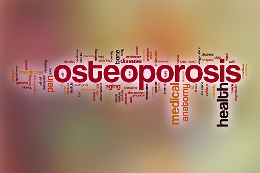Osteoporosis, also known as brittle bone disease, is a condition characterized by the loss of normal bone density, causing weak and fragile bones. Let's have a closer look...

A bone is a living tissue, and can break and repair itself, like all tissues. But age diminishes its reconstruction capacity, resulting in spaces (tiny holes) which reduce its density. The bone becomes fragile and causes fractures (cracks) in the hip or compressions in the vertebra. Bones are made up collagen, calcium, and protein―deficiency of these also leads to osteoporosis. The spine, hips, and wrists are most affected by bone fractures caused due to osteoporosis. Although, all skeletal bones are also vulnerable to osteoporosis-related fractures.
The symptoms are not noticed unless a fracture occurs, after which, there is a noticeable pain that radiates to other parts of the body. In osteoporosis, healing takes longer, and in the process, it could fracture a number of other bones. This condition cannot be cured completely, but can be prevented and managed. Prevention will help increase bone density and strength, whereas, early detection and timely treatment can decrease the risk of future fractures.
Hormone Therapy (HT)
This therapy helps prevent bone loss and fractures, and increases bone density. It is known to help in preventing osteoporosis in post-menopausal women. Estrogen-based medication is commonly prescribed by doctors. Progesterone is also routinely given in combination with estrogen However, hormone therapy doesn't suit everyone, and is known to cause some side effects.
Prescription Medications
Raloxifene (Evista): It belongs to a class of drugs called selective estrogen receptor modulators (SERMs). It has similar healing properties as estrogen, minus the side effects of increased risk of breast and uterine cancer.
Bisphosphonates: This group of medication helps increase bone density in the spine and hip, and reduces the risk of fractures by preserving bone mass and inhibiting bone breakdown.
Teriparatide (Forteo): This drug has similar properties of a parathyroid hormone, and is used to treat osteoporosis in post-menopausal women, and men. Unlike other therapies that prevent further bone loss, teriparatide stimulates new bone growth.
Calcitonin: This hormone is produced by the thyroid gland and helps reduce bone loss. In some patients, it is known to provide pain relief from compression fractures in the spine. It is either administered through an injection or as a nasal spray.
Strontium Ranelate: This drug encourages the growth of new bone tissues, and is useful for women with menopausal symptoms, as it lowers the chances of breaking any bones.
Nutritional Supplements
Nutritional supplements like calcium and vitamin D are usually prescribed to ensure maximum effectiveness of the drug therapy. Adequate intake of calcium, protein, and vitamin D helps maintain bone density and prevent osteoporosis.
Nutrition and Lifestyle Factors
A balanced diet rich in calcium and protein will help make the bones stronger and reduce chances of further breakage. Milk, milk based products, calcium-fortified orange juice, and salmon are some of the calcium rich foods one can consume. Curtailing alcohol intake and smoking is also beneficial in treating osteoporosis.
Certain weight-bearing exercises like riding stationary bicycles, walking or jogging will help reduce the probability of bone fractures associated with osteoporosis. Special exercise programs under medical supervision can help in rehabilitation after a fracture. Exercising will also help in maintaining a good body weight, as being over or under weight further aggravates osteoporosis.
Alternative Physical Therapy Program
Weighted kypho-orthosis (WKO) is a new physical therapy which has been designed to reduce back pain, benefit posture, and reduce the risk of falls in patients with osteoporosis. WKO is a harness with a light weight attached, and is worn daily for 30 minutes in the morning and afternoon, and while performing back extension exercises. Although this treatment is still in its infancy, it has shown some significant improvements in patients suffering from osteoporosis.
Psychological and Emotional Therapy
Many patients with severe osteoporosis incline towards depression, as this bone disease affects movement and tends to increase dependency on others. It is important to ensure continuous support, as it would help in lessening the feelings of isolation and depression.
Osteoporosis can affect anyone, though it is observed more in menopausal women. It can't be cured, but can be managed with a combination of medical treatment and a few lifestyle changes.


 A bone is a living tissue, and can break and repair itself, like all tissues. But age diminishes its reconstruction capacity, resulting in spaces (tiny holes) which reduce its density. The bone becomes fragile and causes fractures (cracks) in the hip or compressions in the vertebra. Bones are made up collagen, calcium, and protein―deficiency of these also leads to osteoporosis. The spine, hips, and wrists are most affected by bone fractures caused due to osteoporosis. Although, all skeletal bones are also vulnerable to osteoporosis-related fractures.
A bone is a living tissue, and can break and repair itself, like all tissues. But age diminishes its reconstruction capacity, resulting in spaces (tiny holes) which reduce its density. The bone becomes fragile and causes fractures (cracks) in the hip or compressions in the vertebra. Bones are made up collagen, calcium, and protein―deficiency of these also leads to osteoporosis. The spine, hips, and wrists are most affected by bone fractures caused due to osteoporosis. Although, all skeletal bones are also vulnerable to osteoporosis-related fractures.